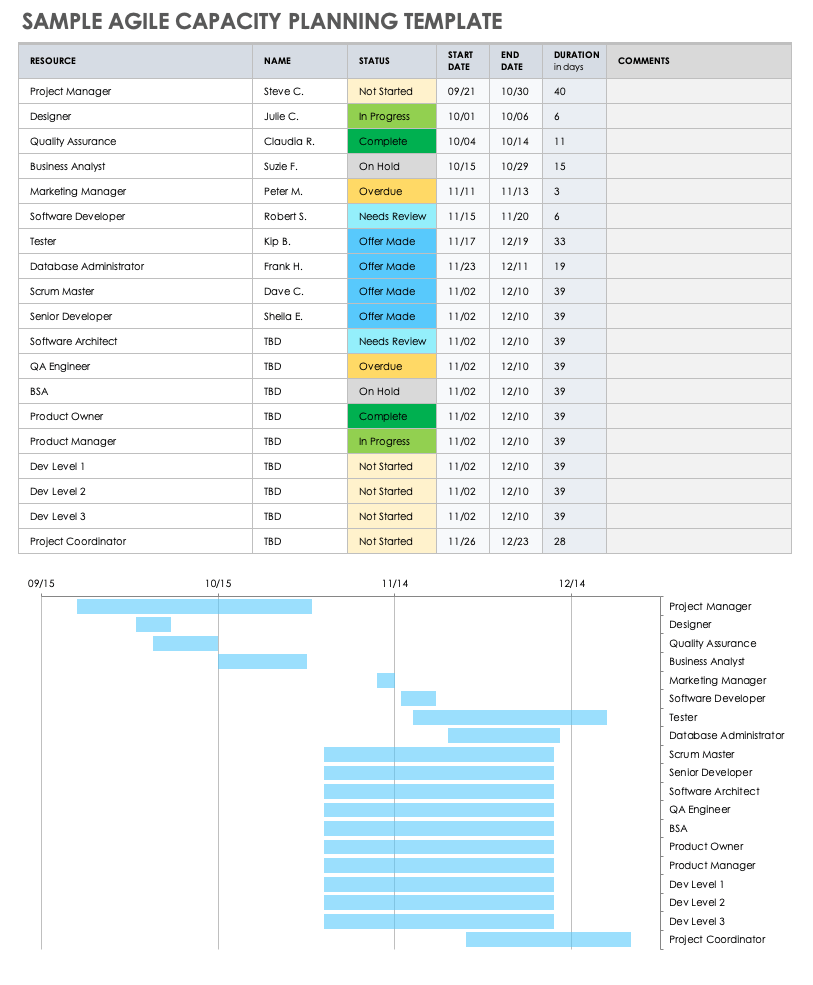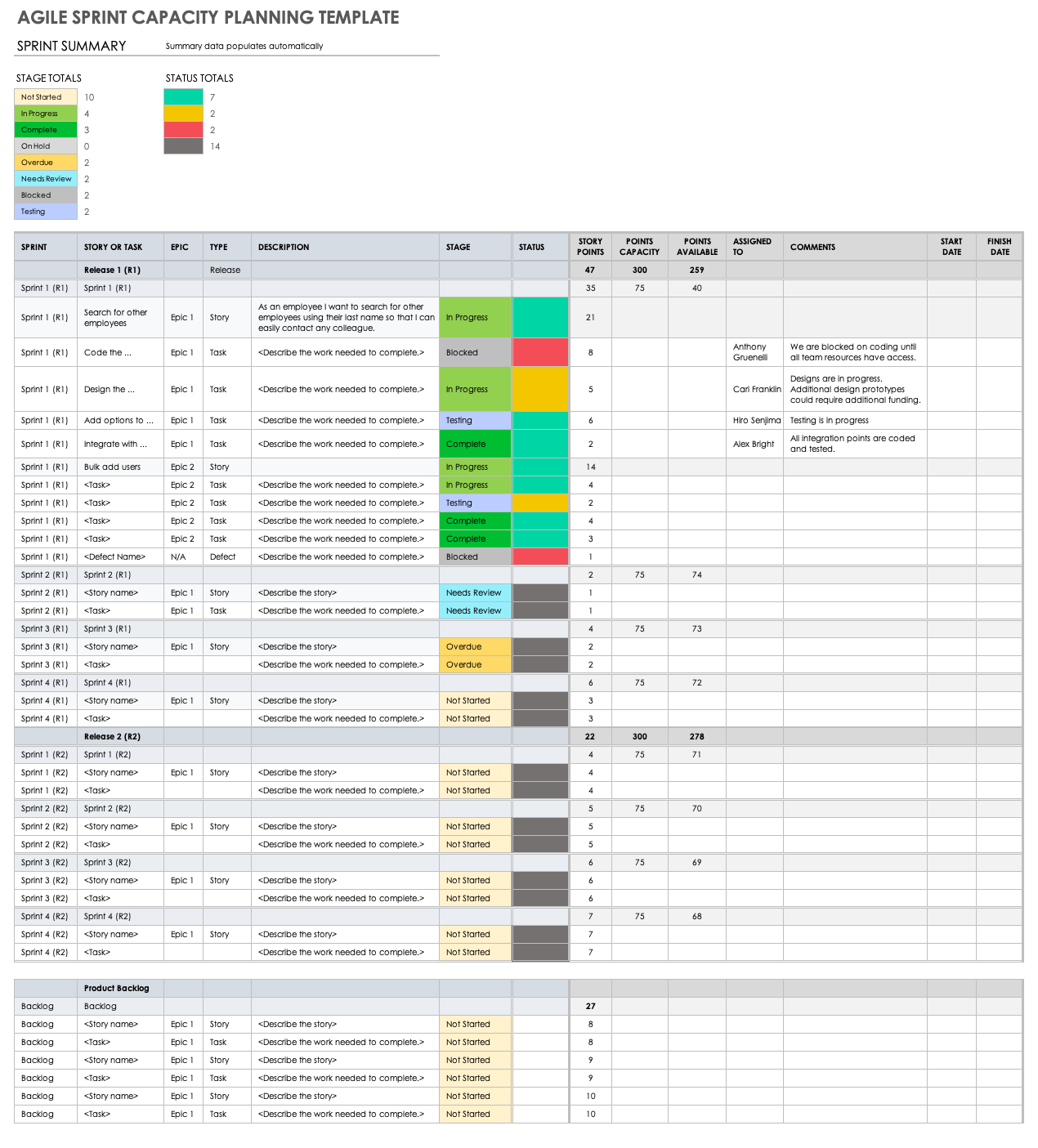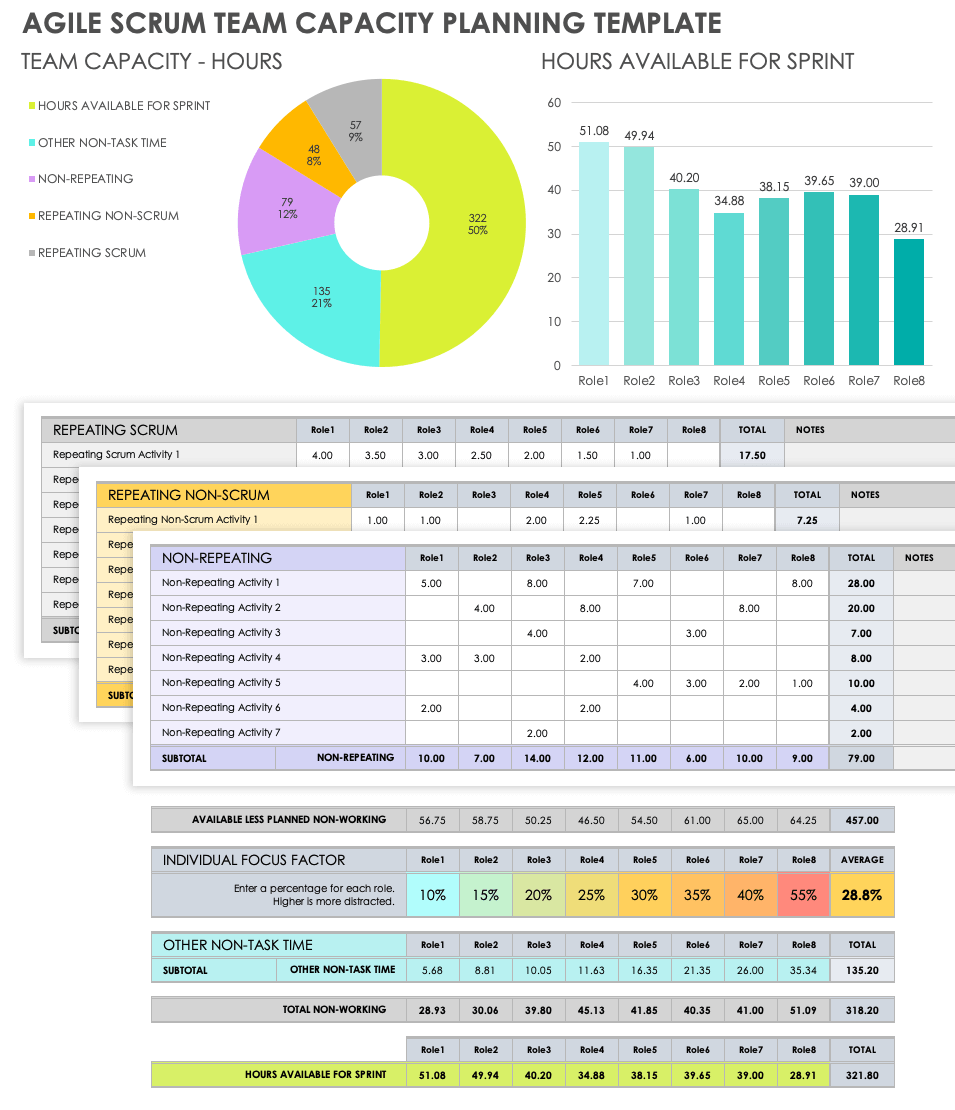Agile Capacity Planning Template
Download an Agile Capacity Planning Template With Example Data for
Excel
| Google Sheets
Download a Blank Agile Capacity Planning Template for
Excel
| Google Sheets
This easy-to-use Agile capacity planning template can help Scrum masters and other Agile team members eliminate the guesswork from their capacity planning process. The template comes pre-filled with Agile team roles, such as project managers, software developers, QA engineers, product managers, and more. Each role's fulfillment status can be tracked in a status column. This allows stakeholders to easily understand where the capacity planning process stands in relation to the business's resource requirements. Additionally, a corresponding Gantt chart can be used to visualize the capacity planning for all Agile project and team needs.
Agile Sprint Capacity Planning Template
Download an Agile Sprint Capacity Planning Template for
Excel
| Google Sheets | Smartsheet
This Agile sprint capacity planning template helps you plan your sprints, prioritize your work, and assign story points for upcoming sprints. It's easy to use, and you can see visually-rich, auto-tallying totals for story points, points capacity, and points available. With the report section, you can monitor your available sprint capacity and the status of each task or story to ensure you deliver your releases on time and to the satisfaction of all your Agile team members and stakeholders.
Agile Scrum Team Capacity Planning Template
Download an Agile Scrum Team Capacity Planning Template for
Excel
| Google Sheets
Agile development team members and Scrum masters will find no better capacity planning tool than this visually rich Agile Scrum team capacity planning template. List each required resource and estimate the start and end dates as well as the duration for each, and track each role’s fulfillment capacity. An accompanying Gantt chart displays start and end dates for each resource, as well as visuals for duration in days, providing the big-picture view of Scrum capacity planning, execution, and delivery.
Agile Project Capacity Planning Template
Download an Agile Project Capacity Planning Template for
Excel
| Google Sheets | Smartsheet
Use this Agile project capacity planning template as a single-source, project-by-project capacity planning tool. This two-part template includes project-by-project capacity planning for each existing or required resource and a Gantt bar chart visual to illustrate your project’s resource and capacity schedules, as well as fulfillment status. This template will help you account for the capacity details on team projects as requirements evolve and your business grows.
What Is an Agile Capacity Planning Template?
An Agile capacity planning template considers the specific needs of Agile methodology, such as resources with Agile-friendly skills and the ability to work in two- or four-week sprints. Using a template can help Agile teams effectively plan and allocate resources.
Continual improvement is a primary principle of the Agile methodology, so effective Agile capacity planning should prioritize collaborative and self-organizing resources. Additionally, a successful Agile capacity plan requires an understanding of adaptive planning and the flexibility to adjust to sudden changes in development requirements.
Whereas resource planning involves managing and accounting for resources to complete a task or project, capacity planning requires precise forethought for a team’s or organization’s future requirements. Agile capacity planning also ensures the resources filling those roles have Agile-friendly skill sets to facilitate success as they continue to refine their Agile development practices.
What Is a Sprint Capacity Planning Template?
A sprint capacity planning template is designed to account for the time-boxed periods of development, known as sprints, used in Agile methodology. These sprints are typically two- or four-week incremental periods that maximize development efficiency and productivity.
Using a sprint capacity planning template allows a team to prioritize development items such as epics, stories, tasks, and bug fixes, manage their backlog of to-do items, and assign story points to items for upcoming sprints. With the help of an Agile sprint capacity planning template, teams can compare the point tallies sprint-by-sprint to their capacity, determining whether they can take on more work before the end of the sprint. Prior to starting a sprint, Scrum masters or project managers can refer to the quantified capacity hours, which are automatically tallied by the template, to assess how much work each team member can accomplish and to determine the overall capacity of the team for a successful sprint.
Read this sprint planning guide to learn more about this process.
What Is a Scrum Capacity Planning Template?
A Scrum capacity planning template assists project managers, product owners, Scrum masters, and their teams in following Agile development practices for delivering improved products in short, iterative releases. Use a Scrum capacity template to plan, track, and manage Agile sprints.
A Scrum capacity template anticipates a project's evolving requirements and ensures the availability of resources with the required skills to meet Agile project demands. For proactive development releases, you need an Agile delivery method that considers your team's or organization's actual Agile capacity and manages every epic, story, task, and bug fix in your pipeline effectively. In contrast, a one-off resource planning template focuses on efficiently managing resources for completing a task or project within Scrum.
How to Use an Agile Capacity Planning Template
An Agile capacity planning template allows you to adjust sprints and releases to meet development goals. Most templates come with pre-filled text to guide you through the planning process, including sprint and release planning, as well as retrospectives.
Agile capacity planning enables instant insight into planning, timelines, and releases for your sprints. With a well-managed Agile capacity planning template, you can track progress and status of epics, user stories, items, and bug fixes, ensuring they are completed by the end of the sprint. You can easily identify if there are roadblocks and if the sprint deliverables or release are at potential risk.
Though Agile capacity planning templates may vary, they often include the following sections:
- Resource: Input the Agile role you are planning capacity for, such as product owner, developer, or Scrum master.
- Name: If the role has been filled, enter the name of the team member.
- Status: Enter the status of the Agile resource you are looking to acquire or have already acquired, such as complete, in progress, offer made, or not started.
- Start Date: Enter the start date for the Agile resource needed for the sprint, release, or project.
- End Date: Enter the end date for the Agile resource needed for the sprint, release, or project.
- Duration in Days: Enter the length of time the Agile resource will be required.
Agile capacity templates often include additional details for Agile release-by-release planning and status updates such as these:
- Agile Task or User Story: Enter the name of the task or user story that needs to be completed during the sprint or release.
- Agile Sprint Number: Enter the number of the sprint or release for which you're planning capacity.
- Agile Story Points: Determine how many story points are necessary for the task or story, based on risk, complexity, and potential repetition.
- Points Capacity: Determine the number of story points the team has for each sprint or release.
- Points Available: Decide how many points are available for Agile team members to add more tasks, stories, or bug fixes for the sprint or release.
- Stage: Enter the current stage of the epic, story, task, or bug fix (e.g., blocked, in progress, testing).
By initially filling out these capacity planning sections in a template, you can be confident that as Scrums, sprints, and releases progress, you have a clear, unified method for tracking details and statuses of development deliverables.
Easily Monitor and Track Agile Capacity Planning with Smartsheet
It’s easy for tasks to get lost in the madness of your everyday work. What you need is a better, more visual way to track and manage tasks.
Empower your team with board view in Smartsheet — a user-friendly task tracking solution that ensures seamless task prioritization, enhanced project visibility, and effortless agile collaboration.
Whether managing projects, optimizing workloads, or tracking to-dos, board view helps eliminate unnecessary status meetings by letting team members track project progress, completed tasks, and upcoming work with task cards.
Discover the intuitive drag-and-drop cards, real-time collaboration, and organizational card nesting that drive your organization to adapt and deliver more effectively.
Learn more about board view in Smartsheet.



